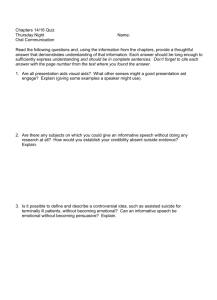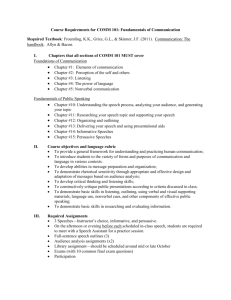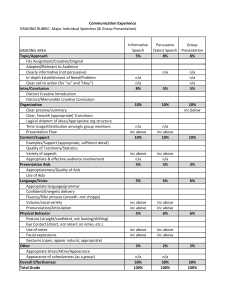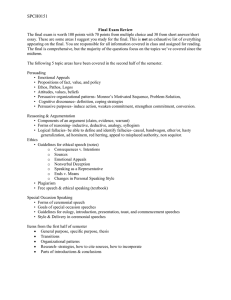STATE UNIVERSITY OF NEW YORK COLLEGE OF TECHNOLOGY CANTON, NEW YORK
advertisement
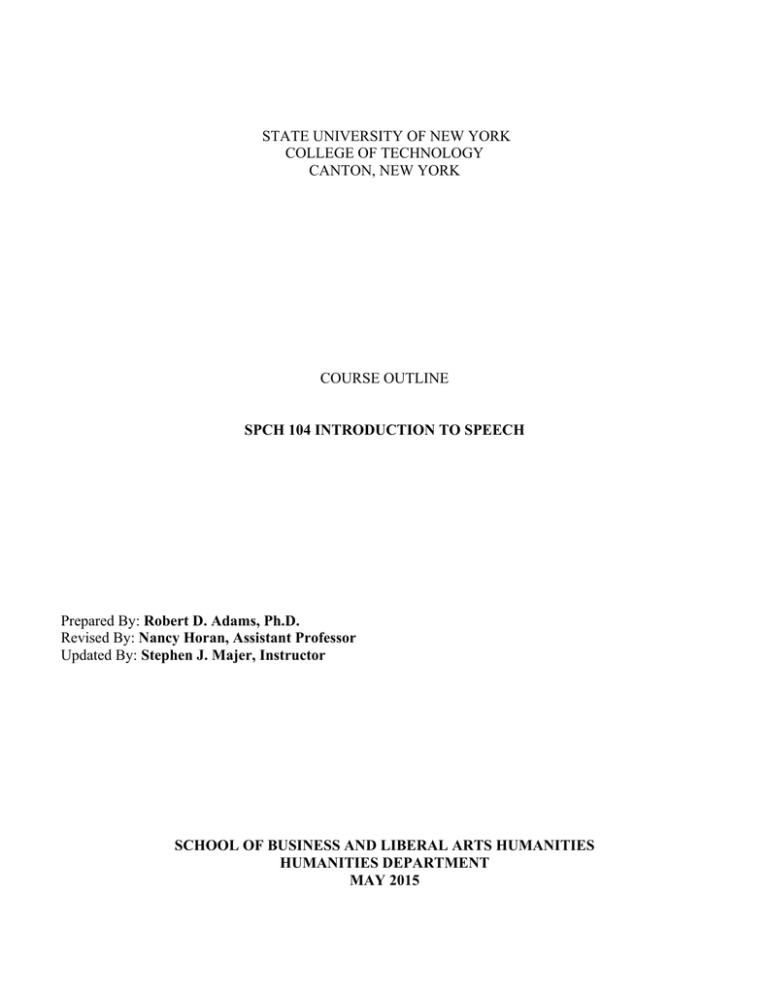
STATE UNIVERSITY OF NEW YORK COLLEGE OF TECHNOLOGY CANTON, NEW YORK COURSE OUTLINE SPCH 104 INTRODUCTION TO SPEECH Prepared By: Robert D. Adams, Ph.D. Revised By: Nancy Horan, Assistant Professor Updated By: Stephen J. Majer, Instructor SCHOOL OF BUSINESS AND LIBERAL ARTS HUMANITIES HUMANITIES DEPARTMENT MAY 2015 SPCH 104 - INTRODUCTION TO SPEECH A. TITLE: Introduction to Speech B. COURSE NUMBER: SPCH 104 SHORT TITLE: Intro Speech C. CREDIT HOURS: 3 D. WRITING INTENSIVE COURSE (OPTIONAL): E. COURSE LENGTH: 15 weeks F. SEMESTER(S) OFFERED: G. HOURS OF LECTURE, LABORATORY, RECITATION, TUTORIAL, ACTIVITY: 3 hours per week H. CATALOGUE DESCRIPTION: This course is an introduction to the principles of effective speech communication. It includes techniques of audience analysis, establishing credibility as a speaker, planning, organizing and researching material, and delivery and use of audio visual aids. Both informative and persuasive speaking are covered. Three hours per week. I. PRE-REQUISITES/CO-COURSES: None J. GOALS (STUDENT LEARNING OUTCOMES): a.Plan, organize, and research the content of an oral speech. b.Deliver speeches c.Use visual aids effectively 1. Comm Skills 2. Critical Thinking 4. Inter-Intrapersonal Skills 1. Comm Skills 1. Comm Skills 2. Critical Thinking 4. Inter-Intrapersonal Skills K. TEXTS: (Representational) Michael Osborn & Suzanne Osborn, Public Speaking L. REFERENCES: No specific references: library research required M. EQUIPMENT: Classroom computer N. GRADING METHOD: A-F O. MEASUREMENT CRITERIA/METHODS: -participation -speech writing -outlines -speeches -research -evaluations (self and other speakers) P. TOPICAL OUTLINE: Q. LABORATORY OUTLINE: DETAILED OUTLINE SPCH 104 - INTRODUCTION TO SPEECH TOPICS I. Foundation of Public Speaking A. B. C. II. First Speech A. B. C. D. III. Nature and Importance of Effective Listening Overcoming Barriers to Effective Listening Developing Critical Thinking and Listening Skills Evaluating Speeches Ethical Responsibilities as a Listener Adapting to Audience and Situation A. B. C. D. V. Understanding Impressions Introducing Self and Others Developing the First Speech Controlling Communication Anxiety Developing Listening Skills A. B. C. D. E. IV. Benefits of Public Speaking Public Speaking as Communication Speaking and Ethics Adapting for Audience Dynamics Adjusting to Audience Demographics Meeting the Challenges of Audience Diversity Adjusting to the Communication Situation Selecting and Researching Topics A. B. C. D. Finding a Good Topic Determining the Purpose Acquiring Responsible Knowledge Recording Information VI. Using Supporting Materials in the Speech A. B. C. D. E. F. VII. Structuring the Speech A. B. C. D. E. VIII. Uses and Advantages of Presentation Aids Kinds of Presentation Aids Presentation Media Preparing Presentation Aids Using Presentation Aids Using Language Effectively A. B. C. XI. Developing a Working Outline Developing a Formal Outline Developing a Key-Word Outline Presentation Aids A. B. C. D. E. X. Principles of Good Form Structuring the Body of the Speech Using Transitions Introducing the Message Developing an Effective Conclusion Outlining the Speech A. B. C. IX. Facts and Statistics Testimony Examples Narratives Three Techniques for Using Support Materials Deciding What Support Material to Use The Power of the Spoken Word Using Language Resources Using Language Effectively Presenting the Speech A. B. C. D. What Makes an Effective Presentation Methods of Presentation Using Voice Effectively Using the Body to Communicate XII. Informative Speaking A. The Functions of Informative Speaking B. Helping the Audience Learn C. Types of Informative Speeches D. Speech Designs XIII. Persuasive Speaking A. B. C. D. E. Characteristics of Persuasive Speaking The Process of Persuasion The Challenges of Persuasion Major Persuasive Functions Designs for Persuasive Speaking XIV. Evidence, Proof, and Argument A. B. C. D. XV. Using Evidence Effectively Proving Points Forming Arguments Avoiding Defective Persuasion Ceremonial Speaking A. B. Techniques of Ceremonial Speaking Types of Ceremonial Speeches
